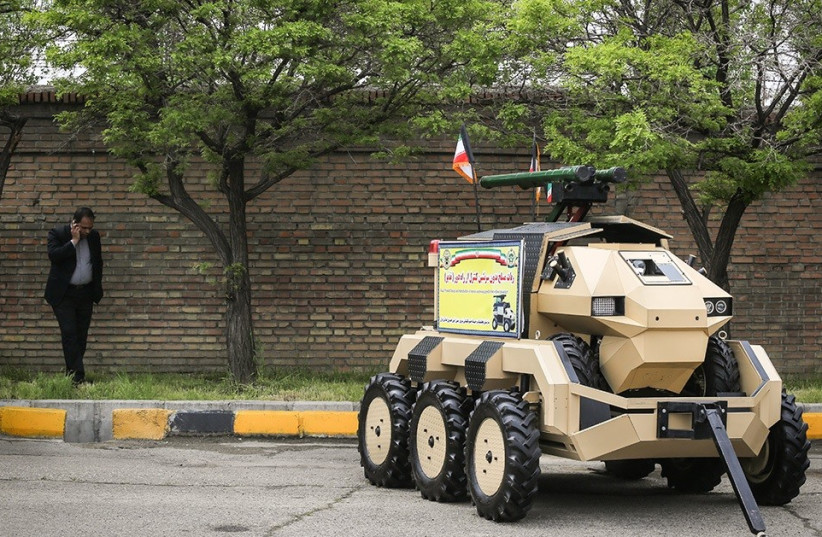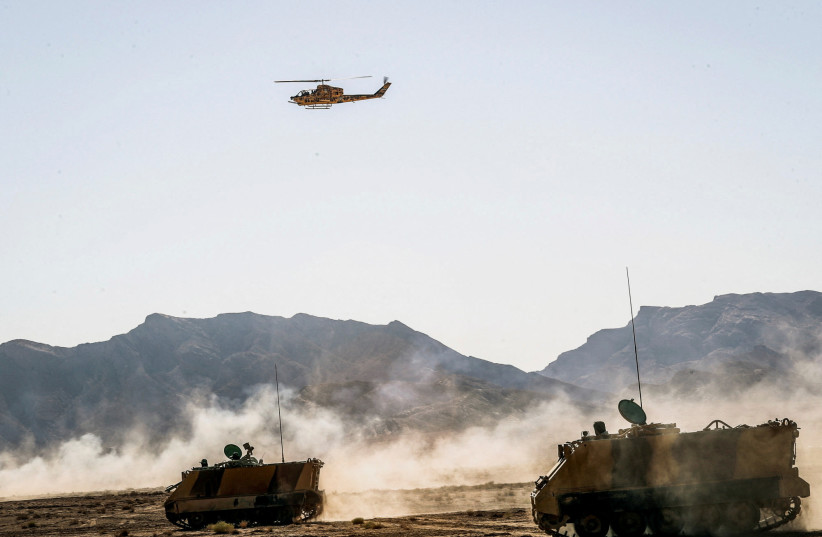Iran showcased a legion of miniature tank robots, remote-controlled four and six-wheeled machines fitted with an assortment of small arms.

As Western states line up to supply sophisticated battle tanks to Ukraine, Iran is unveiling its own tank army.
Iran showcased a legion of miniature tank-robots – remote-controlled, four- and six-wheeled machines fitted with an assortment of small arms.
This is not new. It has been in development for years, but now the regime is claiming to have added “artificial intelligence” and new technology into the machines. The new machines include remote-controlled vehicles that have AK-47s attached to them and may include limited artificial-intelligence applications.
Fars News Agency, associated with the Islamic Revolutionary Guard Corps (IRGC), addressed this new tank army in a report this week. The industry of the “Islamic Republic” is working on producing new military equipment, it reported.
This is not a new tactic for the Islamic Republic; it developed this local industry due to sanctions, which dictate that no one will openly sell Iran major defense systems at the moment.

Ironically, Tehran has been supplying drones to Russia, a new leap in Iran’s military industrial complex as well as its reputation. Iran is building new systems in various sectors, which is a major accomplishment, Fars reported.
What is Iran’s new military technology that they are focusing on?
This focus on new military technology comes as the regime is celebrating the 44th anniversary of the Islamic Revolution.
“We have examined the capability of designing and producing artificial-intelligence vehicles by the defense industries of the Islamic Republic of Iran,” the report said.
Ostensibly, AI means the computers on the military systems, or which operate the weapons, can “learn.” This kind of deep learning can involve processes such as automatically recognizing targets so that users can click on a screen and order the machine to destroy or investigate the target.
While some of this technology is based on algorithms and other applications, not all of it actually is AI. But Iran wants to claim that it is keeping up with Western countries and its adversaries, such as Israel.
The report said the “knowledge of AI is one of the newest sciences that have been able to show their importance in all fields, especially the military field, during the last few decades. Armed forces around the world have been using this science in recent years, which can be seen in many robots and drones.”
These drones refer to unmanned vehicles, also known as UGVs or ground robots. UGV robots are small vehicles that contain weapons or armor and electro-optics that can be used on the battlefield. Robots or unmanned vehicles are good for exploring areas that might be mined, or sometimes they can bring equipment to troops who are in a gunfight or evacuate the wounded. They are also useful for patrolling borders, where soldiers might face sniper fire; the robot can drive along safely and do the job in place of the soldier.
The “use of artificial intelligence in areas such as robotic vehicles, artillery shells, simulators and drones has been among the most important areas of application of this science in the armed forces of the Islamic Republic of Iran,” the report said.
Iran’s ground forces have been able to design and build remotely controlled vehicles that have AI to be used in irregular warfare, it said.
The Nazir is a large vehicle, the size of a bear or small elephant, with six wheels. It has been around for almost a decade and is the first generation of Iranian unmanned vehicles. A four-wheeled version of it also exists. It also has a “flexible chassis” and can drive in various types of terrain. It has an electric engine and can drive up to 2 km., the report said.
Iran has claimed it has day-and-night optics to conduct surveillance and can be mounted with a 7.62-mm. weapons system. It weighs 600 kg. and can also carry cargo and food for soldiers.
The Haider, by contrast, is a much smaller vehicle, dating from 2018. It is about the length of an AK-47, less than a meter, with six wheels. It is supposed to be used in the capacity as a “sniper, suicide bomber, mine thrower or reconnaissance,” according to the report. It can also network with other vehicles. “It is possible to coordinate several Haider robots in the form of a robotic network to carry out multilateral combat operations,” the report said.
Iran says it has openly developed a “suicide robot” that can hide and ram into enemy armored vehicles “such as tanks and armored personnel carriers.” This is the same learning curve that Iran went through with drones: It first developed drones and then packed them with explosives and made kamikaze drones that it provided to Russia.
The “designers and operators of the operations can use these suicide robots to penetrate into the enemy’s trenches and destroy the enemy’s key commanders,” the report said.
Furthermore, Iran has claimed that the Haider was produced in response to large tanks and columns of vehicles in the possession of Iran’s enemies. Whereas the Nazir was supposedly developed during the ISIS war, this was designed to confront US forces in Iraq and Syria, as well as the vehicles of other partners of the US, such as Israel and Saudi Arabia.
A photo of the Haider included in the report shows it armed with an AK-47, mounted upside down. AK-47s are reputed to be able to fire in all conditions, so it makes sense to put such a robust weapon on the vehicle. But it remains unclear how mounting it upside down enables the user to aim it correctly.
The Caracal is six-wheeled as well, and like the Haider, it can be armed. This is the latest incarnation of the Iranian mini-robot AI army, unveiled in 2019, according to the report.
“Caracal is an intelligent ground robot that uses an independent suspension system,” the report said. “The maximum speed of Caracal is 30 km/h, and it can keep commanders’ hands open for tactical operations.”
It is a very simple vehicle and can carry various types of “light and semi-heavy” weapons. It is also equipped with an “intelligent remote-control system with a laser range finder.”
It is unclear what this “intelligent” system can do. Other similar UGVs have systems that help in route-finding. It is also unclear if Iran imports some of the chips, wheels and other technology used in making these systems.
Iranian drones have been found to have small parts with origins all over the world, which stands in contrast to Iran boasting that it builds all of this equipment locally.
Content retrieved from: https://www.jpost.com/middle-east/article-730433.